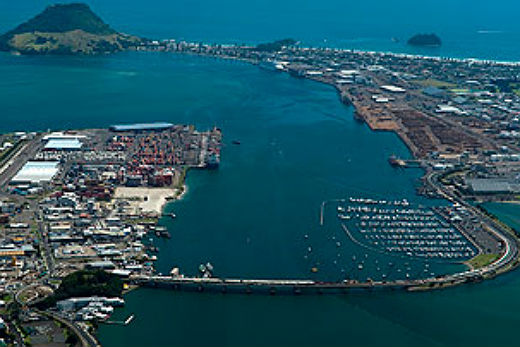A bureaucratic battle is looming between the Bay of Plenty Regional Council and Tauranga City Council over how the organisations handle tsunami hazard risks.
Photo: file.
Tauranga City Council is opposing the regional council's entire tsunami hazard risk policy, as contained in the proposed Regional Coastal Environment Plan.
At this week's TCC City Vision Committee meeting, city planners said they are particularly opposed to the regional council's proposed 100m hazard assessment for harbour, estuary and cliff erosion.
TCC environmental policy manager Andy Ralph says the 100m is an arbitrary line that has no evidential basis.
If unopposed the Regional Coastal Environment Plan will place significant burdens on landowners where land has been zoned for residential use, and it isn't justified through any formal research or considerations, says Andy.
At Tuesday's City Vision Committee meeting the council showed it intends opposing the entire tsunami hazard risk policy until susceptibility mapping has been undertaken by the regional council, as per the draft Regional Policy Statement.
Three BOP councils – Tauranga City, Western Bay of Plenty District Council and the BOP Regional Council – are in the middle of a joint project studying inner harbour erosion impacts.
Preliminary findings show average erosion rates are between 0.08m and 0.15m and over a 100-year period eight metres and 15 metres.
Until the work is finalised TCC's current 15 metre buffer might be more appropriate, says Andy.
Mayor Stuart Crosby wants his council to adopt a more conciliatory role.
'Rather than going straight into conflict, which is what you are doing,” says Stuart.
'The submission seeking deletion of the tsunami hazard section needs to be made, but it needs to be played.” Stuart suggests an explanation with the submission.
TCC and its consultants have been discussing tsunami risk for some time.
The proposed regional coastal environment plan doesn't stipulate a tsunami return period in its tsunami hazard risk – which is the average calculation of how often a dangerous happens.
The TCC consensus is the one in 1000-year return period is appropriate for land-use, while a one in 2500 years is appropriate for emergency management purposes.
'Most of the hazards we face in the Bay of Plenty are regionally significant; earthquakes, volcanic,” says Andy.
'We've been working with them at a technical level to try and get good scientific method about the hazards and that still has a way to go. We've had a series of tsunami reports done on the coast, which good basis for planning ahead.
'There are two stands of work going ahead on tsunami, the emergency management work building the resilient community, and land-use planning, what rules and regulations to try and assist; and the two have to work totally together.”
The Regional Coastal Environment Plan doesn't have rules for the land, it has policies.
One of the policies is the 100-metre band for which there's no scientific basis. That's why it should be opposed, says Andy.
Public submissions to Bay of Plenty Regional's draft Coastal Environment Plan close on August 22. To find view the BOP State of Environment Report, click here.



6 comments
Around and around,
Posted on 17-08-2014 11:02 | By Sambo Returns
in circles!!!!, heaven help us if we actually have a significant Tsumami though, as policy will still be being disputed in a room somewhere in Council,get over it and get it done, you never know a life maybe saved.
Submission process
Posted on 17-08-2014 13:22 | By YOGI BEAR
So now TCC are on the blunt end of the submission process and are about to be treated in the same fashion as done to the public at large and generally speaking. In end result TCC will be ignored by BOPR and the decision will just be made anyway and despite commonsense, realism and whatever other logical reason would say otherwise.
Tsunamis and earthquakes
Posted on 17-08-2014 14:27 | By Johnney
It's a shame the council don't reject the governments policy on earthquake strengthening on buildings. We are in the same situation where everyone are just taking guesses on what could happen on some that May or may not happen. The risk of loss of life has proved to be an average of 4 deaths per year over the last 100 years. Pale in comparison to road deaths, drownings and people frying in their houses.
Beyond Human Control
Posted on 17-08-2014 15:51 | By Mary Faith
Anyone who saw those enormous waves pushing into Japan will know that nature knows no boundaries. If it is going to happen then 15 metres - 100 meters whatever, is not going to make any difference! Leave things as they are! If it happens it is out of our control.
Prevarication
Posted on 18-08-2014 08:31 | By Jitter
BOP councils again/still wasting precious time over the tsunami issue. What the people want who are likely to be affected by a major tsunami is a good warning system and more avenues of escape from the vulnerable coastal areas. It is eight years since this subject/problem arose and our BOP councils are still playing around over a decision and with peoples lives. I guess if/when a tsunami does occur BOP councils will say "Nobody told us of people's concerns".
tsunami rules !!!
Posted on 18-08-2014 09:05 | By The Caveman
And here we have TWO councils fighting one another USING RATEPAYER funds. As noted by "Johnney" - an average of 4 deaths per year over the last 100 years pale in comparison to road deaths, drownings and people frying in their houses and by "Mary Faith" - If it is going to happen then 15 metres - 100 meters whatever, is not going to make any difference! Leave things as they are! If it happens it is out of our control. Regardless of the ”law” it's a case of council bureaucrats using ratepayers money to create 'work” to justify their somewhat questionable jobs.
Leave a Comment
You must be logged in to make a comment.